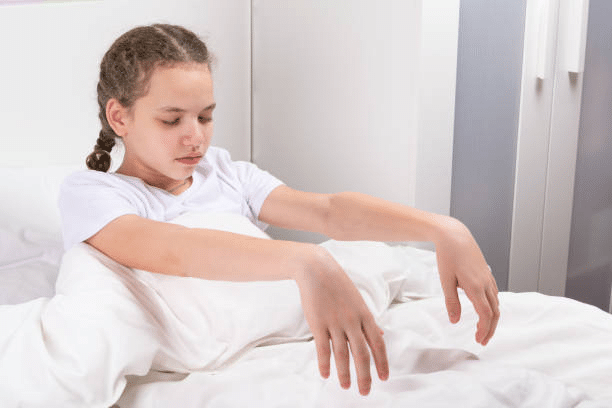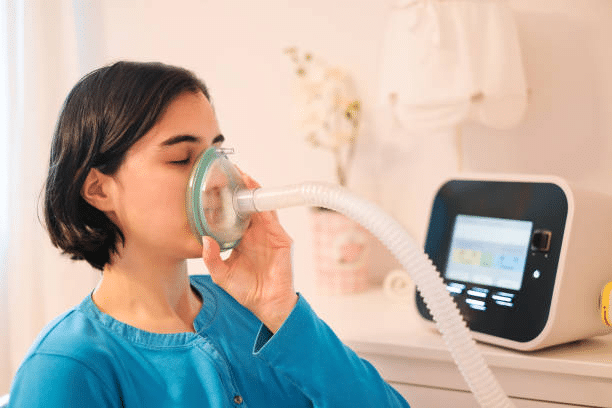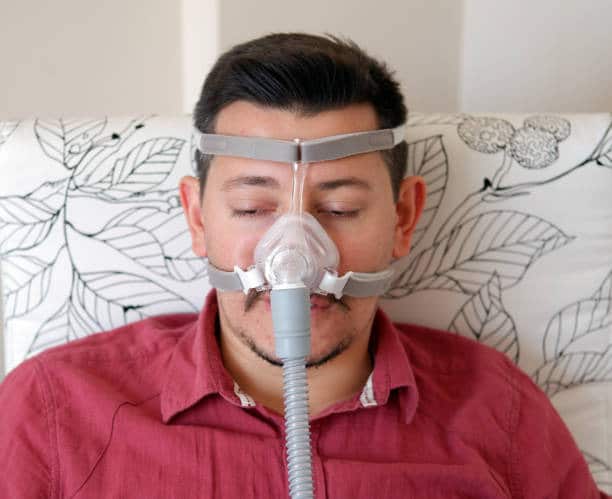The condition of sleepwalking has the potential to be harmful and to injure both the person who is experiencing the episodes and others around them. It is said that up to 15% of the general population has experienced sleepwalking episodes at some point. Although many sleepwalking incidents are mild and largely unproblematic, some may be more serious and even fatal. If left untreated, sleepwalking may result in mishaps, injuries, and aggressive behavior.
This article explain CPAP therapy is a Promising alternative for treating sleep apnea and sleepwalking. Also, we will provide suggestions for anyone who may be having bouts of sleepwalking and stressed about needing medical help.
Understanding Sleepwalking As a Non-Rem Sleep Disorder

Parasomnia, known as somnambulism or sleepwalking, occurs during non-REM (NREM) sleep. There are three phases of NREM sleep: stages I, II, and III (also known as slow-wave or deep sleep).
The deepest stage of sleep, stage III of NREM sleep, is when sleepwalking commonly occurs. It’s different from rest because you’re only half asleep. During sleepwalking, the individual may get up, move about, or carry out complicated actions like cooking or operating a vehicle while still sleeping.
While the exact etiology of sleepwalking is still unknown, it is thought to be associated with disturbances in the regular sleep cycle, especially when deep sleep is being transitioned to lighter NREM sleep or awake periods. Sleep loss, alcohol use, certain medicines, and underlying sleep disorders, including sleep apnea, are all things that might make sleepwalking episodes more likely.
If left untreated, sleepwalking may be hazardous and even life-threatening, mainly if the individual exhibits complicated activities while having an episode. Improved sleep hygiene, avoiding triggers like alcohol and lack of sleep, and, in certain situations, pharmaceuticals such as selective serotonin reuptake inhibitors (SSRIs) are all possible treatments for sleepwalking.
In those diagnosed with both diseases, CPAP therapy, often used to treat sleep apnea, may also be a viable therapeutic option for sleepwalking.
Also Read: CPAP Therapy and GERD: What You Need to Know
The Factors That Influence Sleepwalking Episodes
A partial waking during deep sleep may cause sleepwalking, a sleep disorder. How probable a person is to have bouts of sleepwalking might depend on several variables, including:
Family history and genetics
Research has indicated that certain persons are susceptible genetically to sleepwalking and other non-REM parasomnias. Children are more prone to develop sleepwalking and sleep terrors if one or both of their parents have a history of the disorder.
Lack of sleep
Studies have shown that too little sleep increases the chance of sleepwalking. This could result from spending more time in deep sleep after a sleep deficit.
Medication
Certain sedative-affecting drugs may make bouts of sleepwalking more likely.
Alcohol
Having alcohol in the evening might interfere with your regular sleep patterns and make you more likely to experience sleepwalking.
Brain injury
Disorders that affect the brain, such as encephalitis, might cause a person to start sleepwalking and other sleep paralysis.
Fever
Sleepwalking is more likely to happen when a child has a fever.
Obstructive sleep apnea (OSA)
OSA is a sleep disordered breathing in which the airway becomes clogged, resulting in brief pauses in breathing while you’re asleep. These sleep breaks have the potential to cause sleepwalking.
Restless Leg Syndrome (RLS)
RLS is a sleep problem that causes an extreme need to move the limbs, particularly the legs, when lying down. Sleep disturbances may result from this and cause sleepwalking.
Stress
Various stressors may impact sleep, including increasing fragmentation or disruption of sleep, which can raise the risk of sleepwalking. Stress may be either physical—like pain—or emotional. When you’re traveling and staying the night somewhere new, discomfort or change can cause certain kinds of stress.
It’s important to remember that although most instances of sleepwalking originate in infancy, the disorder may also appear in adults. Also, if a youngster experiences sleepwalking, it’s possible that the episodes end as they age or resume as adults. Individuals may take measures to avoid outbreaks and enhance the quality of their sleep by being aware of the elements that contribute to sleepwalking
Also Read: CPAP Therapy and Bruxism: How CPAP Reduces Teeth Grinding
The Link Between Sleep Apnea And Sleepwalking
Around 4% of adults experience sleepwalking, which may allow people to act out dreams while still awake, including walking, talking, and even driving. If ignored, this illness poses a risk of death and may be deadly.
Obstructive sleep apnea is when the airway closes up entirely or partly. In contrast, you sleep and cause your breathing to continuously stop and resume, which is one possible factor in the development of sleepwalking.
Sleep fragmentation and sleepwalking episodes may result from obstructive sleep apnea. The brain goes through many sleep phases, including REM and deep sleep. A person with breathing interruptions may lose out on the deeper sleep stages, such as the restorative delta sleep, which may lead to delta sleep rebound and cause them to sleepwalk.
CPAP Therapy as an Alternative Treatment for OSA and Sleepwalking

CPAP treatment is a promising alternative for treating obstructive sleep apnea and sleepwalking. To keep the airway open and lessen sleep apnea symptoms, CPAP treatment entails putting a mask over the nose or mouth while sleeping.
Obstructive sleep apnea may be treated with CPAP treatment, and studies have shown that it can enhance sleep quality and lower the risk of sleepwalking. According to one research, 69% of people with severe obstructive sleep apnea who underwent all-night polysomnography and received nasal CPAP treatment had fewer parasomnia symptoms, including bouts of sleepwalking.
Other obstructive sleep apnea symptoms, such as excessive daytime sleepiness, sleep-related hallucinations, and aggressive behavior while asleep, may also be lessened with CPAP treatment. In rare circumstances, CPAP treatment may boost mental health and quality of life.
It is essential to highlight that there are other options for treating sleep apnea and sleepwalking than CPAP therapy. Moreover, surgical procedures, positional therapy, good sleep habits, and medications such as selective serotonin reuptake inhibitors exist. However, CPAP therapy’s efficiency and safety make it a popular first-line treatment.
The Importance of Medical Help and Diagnosis
Getting medical help is critical if you or a loved one has sleepwalking episodes or other sleeping issues. A sleep medicine expert may suggest the best course of therapy after conducting a thorough examination that considers any observed apneic attack. Additionally, a bed partner’s or family member’s report on your sleeping habits can help diagnose obstructive sleep apnea.
Obstructive sleep apnea and sleepwalking are both treatable conditions with CPAP therapy. CPAP treatment helps to maintain the airway open while lowering the frequency of sleep apnea symptoms, which improves sleep quality and reduces the chance of sleepwalking incidents. It is crucial to speak with a sleep medicine expert if you have any sleep-related problems so they can identify the root of the problem and suggest a practical course of action.
The Benefits Of CPAP Therapy For Sleepwalking
Several studies have documented positive outcomes that have looked at the use of CPAP therapy for sleepwalking. One research showed that 86% of patients who used nasal CPAP saw a substantial decrease in sleepwalking episodes. According to further research, CPAP treatment reduced the frequency and severity of sleepwalking episodes in individuals with severe obstructive sleep apnea.
CPAP treatment has been shown to enhance sleep quality, lessen excessive daytime sleepiness in people with sleep apnea, and decrease sleepwalking episodes. Patients who battle sleep difficulties may benefit from improving their general health and quality of life.
Patients with sleep apnea who have to sleepwalk may benefit from CPAP therapy. Continuous Positive Airway Pressure (CPAP) treatment may lessen the risk of sleepwalking by enhancing sleep quality and lowering the frequency and severity of sleep apnea episodes. Speak with a healthcare professional about the advantages of CPAP therapy and if it can be a practical treatment choice if you or a loved one experiences sleepwalking.
Also Read: Longterm Benefits of Using a CPAP
How CPAP Therapy Can Help Sleepwalkers

A parasomnia condition called sleepwalking affects 1 to 15% of the general population. It is a sleep condition that leads people to carry out sophisticated tasks while asleep, such as eating, walking, or even driving, without remembering them afterward. Sleep deprivation, sleep apnea, and certain drugs are among the risk factors for sleepwalking, while the actual reason is unclear.
An irregular breathing pattern while you sleep is a symptom of obstructive sleep apnea. It may result in extreme daytime drowsiness, hallucinations linked to sleep, and broken sleep, all of which can cause bouts of sleepwalking. Obstructive sleep apnea is often treated with CPAP therapy, which employs a machine to keep the airway open while you sleep.
Studies have indicated that CPAP treatment may enhance sleep quality and lower the risk of sleepwalking in those with obstructive sleep apnea. CPAP treatment may improve the quality of sleep and lessen the frequency of sleepwalking episodes by reducing the signs and symptoms of sleep apnea, including documented apneic attacks and frequent awakenings.
Those with sleep apnea and sleepwalking who have undergone Continuous Positive Airway Pressure (CPAP) treatment report considerable improvements in their quality of life. People claim to feel more rested and awake throughout the day, have less disturbing dreams, and have fewer sleepwalking episodes. These first-person accounts prove the beneficial effects of CPAP therapy on the treatment of sleepwalking.
CPAP treatment may lessen the frequency of sleepwalking episodes and enhance the general quality of life. See a sleep medicine expert if you are having trouble sleeping or have been told you have sleep apnea, sleepwalking, or both to determine whether CPAP therapy is the best course for you.
Alternative Treatment Options For Sleepwalking
Fortunately, several therapy options may help control symptoms and lower the chance of sleepwalking episodes. Sleepwalking can be an upsetting and even hazardous illness. Consider these alternate treatment options:
- (CBT) Cognitive behavioral treatment: CBT is a talk therapy that may assist people in controlling their thoughts and actions to lessen the frequency and severity of bouts of sleepwalking. Moreover, CBT may help people recognize the triggers that may be causing their sleepwalking and in creating coping mechanisms for these triggers.
- Prescription drugs: Benzodiazepines and selective serotonin reuptake inhibitors (SSRIs) are two drugs that may help treat sleepwalking symptoms. Because they can have bad effects, these drugs should only be taken under the supervision of a doctor.
- Surgical procedure: Surgery may be suggested in rare circumstances to address sleepwalking. This may involve removing the tonsils and adenoids or surgically treating any underlying medical conditions that may be causing the sleepwalking.
- Sleep treatment: You might be less likely to sleepwalk if you take better care of your sleep. You can do this by creating a relaxing evening routine, sticking to a regular sleep schedule, and not drinking coffee or alcohol before bed.
CPAP therapy may be more suitable for those with sleep apnea and other associated sleep disorders, even if these alternate treatment approaches may successfully treat sleepwalking. To prevent bouts of sleepwalking, CPAP treatment keeps the airway open and lessens sleep apnea symptoms. Talking to a health care professional can help you figure out the best way to treat your specific needs.
Conclusion
To sum up, sleepwalking is a complicated sleep condition that significantly affects a person’s quality of life. CPAP therapy is a successful therapeutic option for those with obstructive sleep apnea, which may exacerbate bouts of sleepwalking.
Medication, such as selective serotonin reuptake inhibitors, and surgery may be further treatments for sleepwalking, although they may not address the sleep apnea that is often a significant factor.
It’s critical for people who have sleepwalking episodes to get medical help and undergo a complete assessment to identify the root cause of their sleep issues. This might include going through all-night polysomnography to check for breathing problems while you sleep, frequent awakenings, and apparent apneic episodes.
CPAP therapy is a viable treatment option for those with obstructive sleep apnea and prone to sleepwalking episodes. It has been shown that CPAP treatment enhances life overall quality, enhances sleep quality, and lowers the chance of sleepwalking.
Sleepwalking may be a problematic sleep condition to manage. Still, with the correct diagnosis and care, a person’s symptoms can be relieved, and their sleep quality and general health can be improved..
For those seeking to enhance their sleep experience and address sleepwalking concerns, our range of CPAP accessories offers practical solutions. Discover the benefits for yourself by exploring our Resway CPAP Solutions, designed to provide comfort and improve your sleep health.



